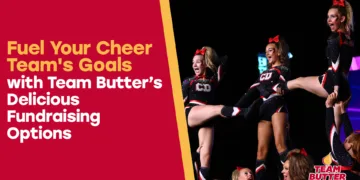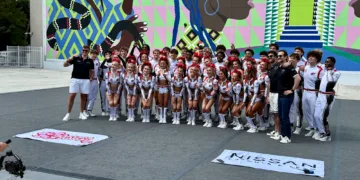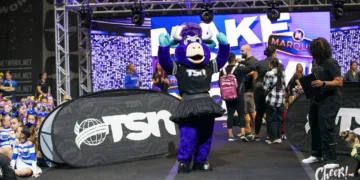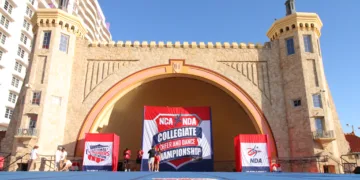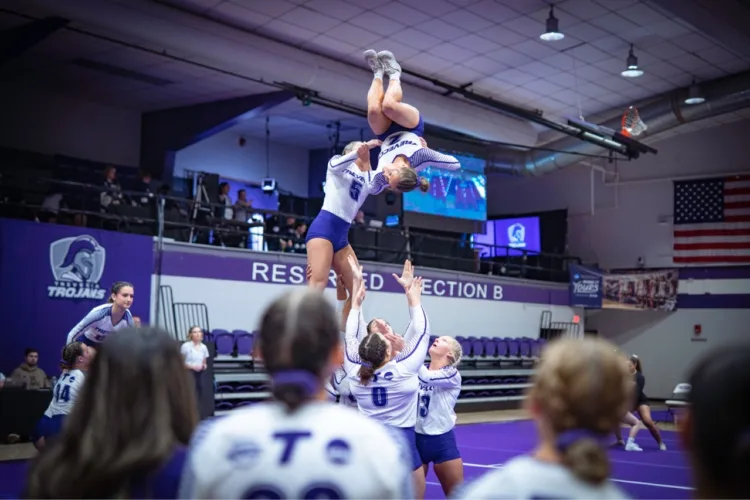Every cheerleader has encountered the question: “Is cheerleading a sport?” Whether it’s said in passing or used to dismiss the effort cheerleaders put into their routines, the assumption often carries weight. But opinions alone don’t define sport. The facts do.
Understanding What Makes a Sport
The Women’s Sports Foundation outlines criteria that help classify physical activities as sports:
- It must be a physical activity involving the propulsion or resistance of mass.
- It must involve competition against opponents.
- It must be governed by standardized rules.
- It must prioritize skill comparison among participants.
Competitive cheerleading checks every box. Stunting, tumbling, pyramids, and baskets require explosive strength, timing, and body control. Teams face off in judged events where scoring rubrics assess difficulty and execution. Competitions operate under timed, rule-based formats on standard mat dimensions. Still, cheerleading lacks universal recognition.
A Split Identity: Spirit Squad vs. Competitive Cheer
Cheerleading encompasses two separate identities: spirit and competition.
Spirit cheerleaders support school athletic programs. They perform during games and pep rallies but do not regularly compete. Their role is more aligned with school spirit and public performance. According to a 2008 clarification from the U.S. Department of Education, spirit squads do not qualify as sports for Title IX purposes.
Competitive cheerleaders, on the other hand, train for head-to-head events. Combining elements from gymnastics, acrobatics, and dance, these athletes execute high-difficulty routines with precision. More than 100,000 U.S. high school students participated in competitive cheer in 2021–22. These routines demand physical conditioning year-round, strength training, choreography synchronization, and mental resilience.
At the elite level, many athletes specialize by position: flyers, bases, and back spots, each with specific strength and technical responsibilities. Execution errors can lead to serious injury, highlighting the intensity and danger of the sport.
Why Isn’t Cheerleading Universally Recognized as a Sport?
Despite meeting physical and competitive benchmarks, cheerleading isn’t officially sanctioned as a sport by the NCAA. Title IX offers limited support unless institutions demonstrate that cheer is the primary competitive focus.
Part of the challenge lies in cheerleading’s historical function. Because many cheerleaders also participate in sideline duties, critics argue that its primary purpose isn’t competition. The NCAA’s stance is that sport designation requires consistent intercollegiate competition. Most cheer teams, even at large universities, compete only once or twice per year. That falls short of the frequency expected in other NCAA sports.
There’s also a structural barrier. The NCAA divides sports by gender, but cheerleading’s most successful competitive teams are coed. As Pam St. John, head cheer coach at the University of Michigan, notes, this complicates efforts to fit cheer into existing NCAA frameworks.
Without formal oversight or a professional league, cheerleading often struggles to secure adequate resources, from athletic trainers and weight room access to scholarships and insurance.
In 2011, USA Cheer introduced STUNT—a format that restructures cheer’s athletic components into a sport-specific, game-like format. STUNT features four quarters: partner stunts, pyramids/tosses, jumps/tumbling, and a team routine. Teams compete side-by-side under identical conditions. It’s designed to meet Title IX’s competition standards.
STUNT is now one of the fastest-growing female sports in the U.S. and represents a viable pathway for colleges to elevate cheer athletes into recognized varsity roles while maintaining traditional spirit programs.
As of 2025, more than 450 high schools and 45 colleges have active STUNT teams, with structured seasons, regular schedules, and playoffs. This format aligns with the definitions used by the Office for Civil Rights in evaluating sports programs.
In a major step forward, the NCAA granted STUNT Emerging Sport for Women status in 2023 and elevated it to Championship Sport status in 2025. This means schools can now count STUNT toward NCAA sport sponsorship requirements and Title IX compliance, and student-athletes in STUNT programs are eligible for NCAA recognition, compliance protections, and postseason play. This elevation validates STUNT as a full-fledged competitive sport and could open the door for broader cheer recognition.
STUNT’s growth has helped reshape public perception, positioning cheerleading more clearly within the athletic landscape.
Safety, Injuries, and Institutional Responsibility
Cheerleading is among the most physically demanding and high-risk high school sports. From 1982 to 2017, cheerleading ranked second in catastrophic injury rates, only behind football. Catastrophic incidents included paralysis, fractures, and concussions.
Institutions bear responsibility for athlete safety and must implement safeguards similar to those in place for sanctioned sports:
- Enforce updated rules: The NFHS updates stunt rules annually to improve safety.
- Emergency action plans: Include concussion and traumatic brain injury protocols.
- Pre-participation medical exams: Screen athletes for risk factors.
- Use of certified coaches: USA Cheer provides training in safety and spotting.
- Proper equipment: Include padded mats and trained spotters.
- Waivers and injury disclosure: Make risks clear and secure athlete consent.
- Event supervision: Ensure quick medical response and proper reporting.
Cheerleading-specific safety measures must match the intensity of its physical demands. Athletes perform inversion skills and airborne stunts that rival those seen in elite gymnastics. A commitment to athlete welfare—regardless of sport classification—is essential.
Momentum for Recognition
Global organizations now recognize cheerleading. In 2016, the International Olympic Committee granted the International Cheer Union full sport recognition in 2021. allowing the ICU to petition for a future Olympic Games. USA Cheer was welcomed by the U.S. Olympic and Paralympic Committee as an affiliate sport body.
Domestically, 30 U.S. states now recognize competitive cheer as a high school sport. This growing list demonstrates increasing momentum at the grassroots level. The National Federation of State High School Associations (NFHS) reports annual increases in competitive cheer participation.
Many U.S. cheer athletes now train in private all-star gyms. These facilities focus entirely on competition, fostering year-round skill development. The U.S. All Star Federation (USASF) oversees safety standards, age grids, and scoring policies, providing competitive structure at the national level.
Yet, without full NCAA recognition of cheer and a professional league, these athletes often reach a ceiling. While some join college teams, others exit the sport in their teens. Unlike soccer or basketball, there’s no league structure or long-term professional career for most cheer athletes.
Cheerleading meets every athletic criterion. Its athletes condition year-round, perform dangerous skills under scrutiny, and compete for judged scores. Yet, recognition as a sport lags behind the reality of its practice. But movements like STUNT and Olympic recognition are pushing change.
Until governing bodies close the gap between cheerleading’s athletic reality and its classification, the fight for full recognition continues.
Want more updates on the recognition, safety, and future of cheerleading? Follow Cheer Daily for expert coverage at cheerdaily.net.









